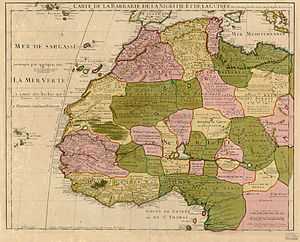Barbary Coast

The Barbary Coast, or Berber Coast, was the term used by Europeans from the 16th until the 19th century to refer to much of the collective land of the Berber people. Today, the term Maghreb corresponds roughly to "Barbary". The term "Barbary Coast" emphasizes the Berber coastal regions and cities throughout the middle and western coastal regions of North Africa – what is now Morocco, Algeria, Tunisia, and Libya. The English term "Barbary" (and its European varieties: Barbaria, Berbérie, etc.) referred mainly to the entire Berber lands including non-coastal regions, deep into the continent, as seen in European geographical and political maps published during the 17–20th centuries.[1]
The name is derived from the Berber people of north Africa. In the West, the name commonly evoked the Barbary pirates and Barbary Slave Traders based on that coast, who attacked ships and coastal settlements in the Mediterranean and North Atlantic and captured and traded slaves or goods from Europe, America and sub-Saharan Africa which finally provoked the Barbary Wars.[2] The slaves and goods were being traded and sold throughout the Ottoman Empire or to the Europeans themselves. The term 'berberi' is an often-used diminutive term referring to dark to black-skinned individuals throughout the Middle East.
History
"Barbary" was not always a unified political entity. From the 16th century onwards, it was divided into the political entities of the Regency of Algiers, Tunis, and Tripolitania (Tripoli). Major rulers during the times of the Barbary states' plundering parties included the Pasha or Dey of Algiers, the Bey of Tunis and the Bey of Tripoli, all subjects who were anxious to get rid of the Ottoman sultan, but who were de facto independent rulers.[3]
Before then, the territory was usually divided between Ifriqiya, Morocco, and a west-central Algerian state centered on Tlemcen or Tiaret. Powerful Berber dynasties such as the Almohads (12th century) and briefly thereafter the Hafsids, occasionally unified it for short periods. From a European perspective its "capital" or chief city was often considered to be Tripoli in modern-day Libya, although Marrakesh in Morocco was the largest and most important Berber city at the time. In addition, Algiers in Algeria and Tangiers in Morocco were also sometimes seen as the "capital".

The first United States military land action overseas, executed by the U.S. Marines and Navy, was the Battle of Derne, Tripoli, in 1805. It formed part of an effort to destroy all of the Barbary pirates, to free the American slaves in captivity, and to put an end to piracy acts between these warring tribes on the part of the Barbary states, which were themselves member states of the Ottoman Empire. The opening line of the "Marine's Hymn" refers to this action: "From the halls of Montezuma to the shores of Tripoli...". This was the first time the U.S. Marine Corps took part in offensive actions outside of the United States.
See also
- Ottoman Algeria
- Ottoman Tripolitania
- Ottoman Tunisia
- Turkish Abductions
- Pirate Coast, region in the Persian Gulf conquered by Europeans in the early 19th century to quell piracy
- Barbary Coast, San Francisco
- Republic of Salé
Footnotes
- ↑ Maps of Barbary
- ↑ Carver, Robert (25 April 2009). "Not so easy alliances: Two Faiths, One Banner: when Muslims marched with Christians across Europe’s battlegrounds (book review)". The Tablet. p. 24.
- ↑
 Chisholm, Hugh, ed. (1911). "Barbary Pirates". Encyclopædia Britannica (11th ed.). Cambridge University Press.
Chisholm, Hugh, ed. (1911). "Barbary Pirates". Encyclopædia Britannica (11th ed.). Cambridge University Press.
External material
References
- London, Joshua E. (2005), Victory in Tripoli: How America's War with the Barbary Pirates Established the U.S. Navy and Shaped a Nation, New Jersey: John Wiley & Sons, Inc., ISBN 0-471-44415-4
- LAFI (Nora), Une ville du Maghreb entre ancien régime et réformes ottomanes. Genèse des institutions municipales à Tripoli de Barbarie (1795–1911), Paris: L'Harmattan, 2002, p. 305
Links
- "When Europeans Were Slaves: Research Suggests White Slavery Was Much More Common Than Previously Believed", Ohio State University
